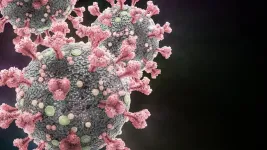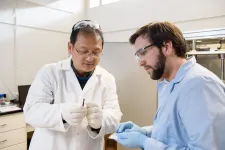(Press-News.org) Although antibodies induced by SARS-CoV-2 infection are largely protective, they do not completely protect against reinfection in young people, as evidenced through a longitudinal, prospective study of more than 3,000 young, healthy members of the US Marines Corps conducted by researchers at the Icahn School of Medicine at Mount Sinai and the Naval Medical Research Center, published April 15 in The Lancet Respiratory Medicine.
"Our findings indicate that reinfection by SARS-CoV-2 in health young adults is common" says Stuart Sealfon, MD, the Sara B. and Seth M. Glickenhaus Professor of Neurology at the Icahn School of Medicine at Mount Sinai and senior author of the paper. "Despite a prior COVID-19 infection, young people can catch the virus again and may still transmit it to others. This is an important point to know and remember as vaccine rollouts continue. Young people should get the vaccine whenever possible, since vaccination is necessary to boost immune responses, prevent reinfection, and reduce transmission."
The study, conducted between May and November 2020, revealed that around 10 percent (19 out of 189) of participants who were previously infected with SARS-CoV-s (seropositive) became reinfected, compared with new infections in 50 percent (1.079 out of 2,247) of participants who had not been previously infected (seronegative). While seronegative study participants had a five times greater risk of infection than seropositive participants, the study showed that seropositive people are still at risk of reinfection.
The study population consisted of 3,249 predominantly male, 18-20-year-old Marine recruits who, upon arrival at a Marine-supervised two-week quarantine prior to entering basic training, were assessed for baseline SARS-CoV-2 IgG seropositivity (defined as a 1:150 dilution or greater on receptor binding domain and full-length spike protein enzyme-linked immunosorbent [ELISA] assays.) The presence of SARS-CoV-2 was assessed by PCR at initiation, middle and end of quarantine. After appropriate exclusions, including participants with a positive PCR during quarantine, the study team performed three bi-weekly PCR tests in both seronegative and seropositive groups once recruits left quarantine and entered basic training.
Recruits who tested positive for a new second COVID-19 infection during the study were isolated and the study team followed up with additional testing. Levels of neutralising antibodies were also taken from subsequently infected seropositive and selected seropositive participants who were not reinfected during the study period.
Of the 2,346 Marines followed long enough for this analysis of reinfection rate, 189 were seropositive and 2,247 were seronegative at the start of the study. Across both groups of recruits, there were 1,098 (45%) new infections during the study. Among the seropositive participants, 19 (10%) tested positive for a second infection during the study. Of the recruits who were seronegative, 1,079 (48%) became infected during the study.
To understand why these reinfections occurred, the authors studied the reinfected and not infected participants' antibody responses. They found that, among the seropositive group, participants who became reinfected had lower antibody levels against the SARS-CoV-2 virus than those who did not become reinfected. In addition, in the seropositive group, neutralising antibodies were less common (neutralising antibodies were detected in 45 (83%) of 54 uninfected, and in six (32%) of 19 reinfected participants during the six weeks of observation).
Comparing new infections between seropositive and seronegative participants, the authors found that viral load (the amount of measurable SARS-CoV-2 virus) in reinfected seropositive recruits was on average only 10 times lower than in infected seronegative participants, which could mean that some reinfected individuals could still have a capacity to transmit infection. The authors note that this will need further investigation.
In the study, most new COVID-19 cases were asymptomatic - 84% (16 out of 19 participants) in the seropositive group vs 68% (732 out of 1,079 participants) in the seronegative group - or had mild symptoms and none were hospitalised.
The authors note some limitations to their study, including that it likely underestimates the risk of reinfection in previously infected individuals because it does not account for people with very love antibody levels following their past infection. They strongly suggest that even young people with previous SARS-CoV-2 infection be a target of vaccination since efforts must be made to prevent transmission and prevent infection amongst this group.
INFORMATION:
This work was supported by the Defense Health Agency through the Naval Medical Research Center and the Defense Advanced Research Projects Agency.
About the Mount Sinai Health System
The Mount Sinai Health System is New York City's largest academic medical system, encompassing eight hospitals, a leading medical school, and a vast network of ambulatory practices throughout the greater New York region. Mount Sinai is a national and international source of unrivaled education, translational research and discovery, and collaborative clinical leadership ensuring that we deliver the highest quality care--from prevention to treatment of the most serious and complex human diseases. The Health System includes more than 7,200 physicians and features a robust and continually expanding network of multispecialty services, including more than 400 ambulatory practice locations throughout the five boroughs of New York City, Westchester, and Long Island. The Mount Sinai Hospital is ranked No. 14 on U.S. News & World Report's "Honor Roll" of the Top 20 Best Hospitals in the country and the Icahn School of Medicine as one of the Top 20 Best Medical Schools in country. Mount Sinai Health System hospitals are consistently ranked regionally by specialty and our physicians in the top 1% of all physicians nationally by U.S. News & World Report.
For more information, visit https://www.mountsinai.org or find Mount Sinai on Facebook, Twitter and YouTube.
In recent years there has been an exhaustive study of red dwarf stars to find exoplanets in orbit around them. These stars have effective surface temperatures between 2400 and 3700 K (over 2000 degrees cooler than the Sun), and masses between 0.08 and 0.45 solar masses. In this context, a team of researchers led by Borja Toledo Padrón, a Severo Ochoa-La Caixa doctoral student at the Instituto de Astrofísica de Canarias (IAC), specializing in the search for planets around this type of stars, has discovered a super-Earth orbiting the star GJ 740, a red dwarf star situated some 36 light years from the Earth.
The planet orbits its star with a period of 2.4 days and its mass is around 3 ...
One of the most comprehensive statistical analyses of drivers of food insecurity across 65 countries has concluded that household income consistently explains more discrepancy in food security than any other factor, including agricultural land resources and production. The Thayer School of Engineering at Dartmouth study, "Cross-national analysis of food security drivers: comparing results based on the Food Insecurity Experience Scale and Global Food Security Index," was recently published by the peer-reviewed journal Food Security.
Given the persistent issue of food insecurity--one of the United Nation's sustainable development goals is to achieve zero hunger--the study's results are vital in determining how best to tackle the complex problem.
"We're ...
Boulder, Colo., USA: Volcanologists' ability to estimate eruption risks is largely reliant on knowing where pools of magma are stored, deep in the Earth's crust. But what happens if the magma can't be spotted?
Shane Rooyakkers, a postdoctoral scholar at GNS Science in New Zealand, grew up in the shadow of Mount Taranaki on the country's North Island, hiking on the island's many volcanoes. Today, his research is revealing hidden dangers that may have been beneath his feet all along.
A new study, published yesterday in Geology, explores a threat volcanologists discovered only recently: surprisingly shallow magma pools that are too small to be detected with common volcano monitoring equipment. Such a magma body was ...
LA JOLLA, CALIF. - April 16, 2021 - Scientists at Sanford Burnham Prebys have identified a set of human genes that fight SARS-CoV-2 infection, the virus that causes COVID-19. Knowing which genes help control viral infection can greatly assist researchers' understanding of factors that affect disease severity and also suggest possible therapeutic options. The genes in question are related to interferons, the body's frontline virus fighters.
The study was published in the journal Molecular Cell.
"We wanted to gain a better understanding of the cellular response to SARS-CoV-2, including what drives a strong or weak response to infection," says Sumit K. Chanda, Ph.D., professor and director of the Immunity and Pathogenesis Program at Sanford Burnham Prebys and lead ...
Scientists have figured out how to modify CRISPR's basic architecture to extend its reach beyond the genome and into what's known as the epigenome -- proteins and small molecules that latch onto DNA and control when and where genes are switched on or off.
In a paper published April 9, 2021, in the journal Cell, researchers at UC San Francisco and the Whitehead Institute describe a novel CRISPR-based tool called "CRISPRoff," which allows scientists to switch off almost any gene in human cells without making a single edit to the genetic code. The researchers also show that once a gene is switched off, it remains inert in the cell's descendants for hundreds of generations, unless ...
Look deep inside the brain of someone with Alzheimer's disease, most forms of dementia or the concussion-related syndrome known as chronic traumatic encephalopathy (CTE) and you'll find a common suspected culprit: stringy, hairball-like tangles of a protein called tau.
Such conditions, collectively known as "tauopathies" strike scores of people across the globe, with Alzheimer's alone affecting six million people in the United States.
But more than a century after German psychiatrist Alois Alzheimer discovered tau tangles, scientists still have much to ...
What The Study Did: The fitted filtration efficiency of commonly available masks worn singly, doubled or in combinations was evaluated in this study.
Authors: Emily E. Sickbert-Bennett, Ph.D., M.S., of the UNC Medical Center in Chapel Hill, North Carolina, is the corresponding author.
To access the embargoed study: Visit our For The Media website at this link https://media.jamanetwork.com/
(doi:10.1001/jamainternmed.2021.2033)
Editor's Note: The article includes conflict of interest and funding/support disclosures. Please see the article for additional information, including other authors, author contributions and affiliations, conflict of ...
CHAPEL HILL, NC - A study published today in JAMA Internal Medicine shows that wearing two face coverings can nearly double the effectiveness of filtering out SARS-CoV-2-sized particles, preventing them from reaching the wearer's nose and mouth and causing COVID-19. The reason for the enhanced filtration isn't so much adding layers of cloth, but eliminating any gaps or poor-fitting areas of a mask.
"The medical procedure masks are designed to have very good filtration potential based on their material, but the way they fit our faces isn't perfect," said Emily ...
Thermoelectrics directly convert heat into electricity and power a wide array of items -- from NASA's Perseverance rover currently exploring Mars to travel coolers that chill beverages.
A Clemson University physicist has joined forces with collaborators from China and Denmark to create a new and potentially paradigm-shifting high-performance thermoelectric compound.
A material's atomic structure, which is how atoms arrange themselves in space and time, determines its properties. Typically, solids are crystalline or amorphous. In crystals, atoms are in an orderly and symmetrical pattern. Amorphous materials have randomly distributed atoms.
Clemson researcher Jian He and the international team created a new hybrid compound in which the crystalline and ...
Russian scientists have proposed a theory of phase transformation in polymer gels. It explains the mechanisms of the dramatic reduction in volume of zwitterionic hydrogels when they are cooled. The results are published in the journal Chemical Communications (ChemComm).
Polymer gels have unusual properties, including the ability to absorb water in volumes hundreds of times greater than their own. For example, some hydrogels are capable of holding up to two kilograms of water per gram of dry gel. By changing the temperature or adding solvents, various desired properties can be achieved. This is why polymer gels are used in industry and biomedicine, including for the targeted delivery of medication, creation of artificial skin, children's toys, etc.
If you take ...





